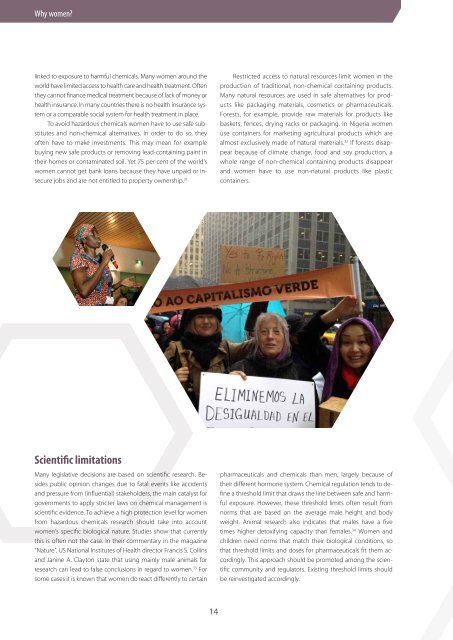Women and Chemicals
1ToENNR
1ToENNR
Create successful ePaper yourself
Turn your PDF publications into a flip-book with our unique Google optimized e-Paper software.
Why women?<br />
linked to exposure to harmful chemicals. Many women around the<br />
world have limited access to health care <strong>and</strong> health treatment. Often<br />
they cannot finance medical treatment because of lack of money or<br />
health insurance. In many countries there is no health insurance system<br />
or a comparable social system for health treatment in place.<br />
To avoid hazardous chemicals women have to use safe substitutes<br />
<strong>and</strong> non-chemical alternatives. In order to do so, they<br />
often have to make investments. This may mean for example<br />
buying new safe products or removing lead-containing paint in<br />
their homes or contaminated soil. Yet 75 per cent of the world’s<br />
women cannot get bank loans because they have unpaid or insecure<br />
jobs <strong>and</strong> are not entitled to property ownership. 31<br />
Restricted access to natural resources limit women in the<br />
production of traditional, non-chemical containing products.<br />
Many natural resources are used in safe alternatives for products<br />
like packaging materials, cosmetics or pharmaceuticals.<br />
Forests, for example, provide raw materials for products like<br />
baskets, fences, drying racks or packaging. In Nigeria women<br />
use containers for marketing agricultural products which are<br />
almost exclusively made of natural materials. 32 If forests disappear<br />
because of climate change, food <strong>and</strong> soy production, a<br />
whole range of non-chemical containing products disappear<br />
<strong>and</strong> women have to use non-natural products like plastic<br />
containers.<br />
Scientific limitations<br />
Many legislative decisions are based on scientific research. Besides<br />
public opinion changes due to fatal events like accidents<br />
<strong>and</strong> pressure from (influential) stakeholders, the main catalyst for<br />
governments to apply stricter laws on chemical management is<br />
scientific evidence. To achieve a high protection level for women<br />
from hazardous chemicals research should take into account<br />
women’s specific biological nature. Studies show that currently<br />
this is often not the case. In their commentary in the magazine<br />
“Nature”, US National Institutes of Health director Francis S. Collins<br />
<strong>and</strong> Janine A. Clayton state that using mainly male animals for<br />
research can lead to false conclusions in regard to women. 33 For<br />
some cases it is known that women do react differently to certain<br />
pharmaceuticals <strong>and</strong> chemicals than men, largely because of<br />
their different hormone system. Chemical regulation tends to define<br />
a threshold limit that draws the line between safe <strong>and</strong> harmful<br />
exposure. However, these threshold limits often result from<br />
norms that are based on the average male height <strong>and</strong> body<br />
weight. Animal research also indicates that males have a five<br />
times higher detoxifying capacity than females. 34 <strong>Women</strong> <strong>and</strong><br />
children need norms that match their biological conditions, so<br />
that threshold limits <strong>and</strong> doses for pharmaceuticals fit them accordingly.<br />
This approach should be promoted among the scientific<br />
community <strong>and</strong> regulators. Existing threshold limits should<br />
be reinvestigated accordingly.<br />
14


